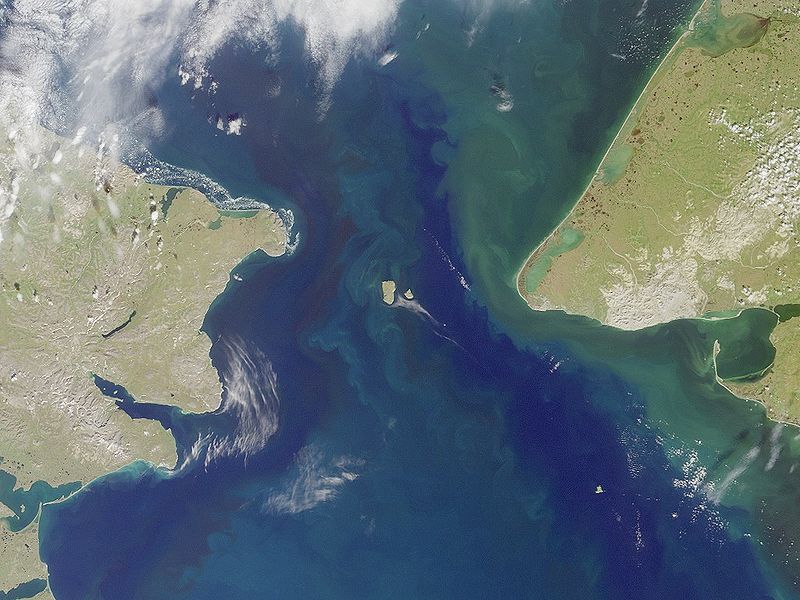Facts for Kids
The Bering Strait is a gateway between the Pacific and Arctic Oceans, separating Russia from the United States.
Overview
Economic Impact
Historical Context
Cultural Interactions
Ecological Importance
Geographic Significance
Bering Land Bridge Theory
Exploration And Navigation
Climate And Weather Patterns
Connectivity Between Continents

Inside this Article
Aleutian Islands
Chukchi People
Climate Change
Pacific Ocean
Vitus Bering
Freezing
America
Pollock
Chukchi
Frozen
Did you know?
🌊 The Bering Strait connects the Pacific Ocean and the Arctic Ocean.
❄️ It is about 50 miles wide at its narrowest point.
🐟 The strait is home to many fish, including cod and salmon.
🦈 Whales and other marine mammals also use the strait for migration.
🏔️ It separates the Chukchi Peninsula of Russia from the Seward Peninsula of Alaska.
💰 Fishing is a major industry around the Bering Strait, providing jobs and food.
⚔️ The area has a rich history of human migration, especially from Asia to North America.
🗺️ Explorers have navigated the Bering Strait for centuries seeking new trade routes.
🌏 The strait is the closest point between the continents of Asia and North America.
🌉 Scientists believe an ancient land bridge once connected the two continents.
Introduction
Economic Impact
Fishing is a major industry, providing food and jobs to many families. The waters are rich in fish like pollock, which is popular around the world. Oil and gas exploration is another big factor. Companies look for resources under the sea floor, which can create jobs and money for local people. However, this can also have effects on the fragile ecosystem, making it important for everyone to care for this precious area!
Historical Context
️ Long ago, people traveled across it. The Chukchi people from Russia and various Native Alaskan tribes share stories of ancestors who crossed the strait. In the 1700s, Russian explorers ventured to Alaska in search of fur-bearing animals and new lands. This led to important discoveries about the region. The strait also reminds us of the “land bridge” theory, supporting the idea that early humans crossed from Asia to North America!
Cultural Interactions
The Chukchi people in Russia and the Inuit in Alaska have lived for thousands of years near the strait. They share similar lifestyles, often relying on hunting, fishing, and gathering. Both cultures use Kayaks 🛶 to navigate the waters. Each summer, they celebrate traditional festivals, dancing and sharing food. These cultural interactions are important for understanding how people adapt to their environments, and they often illustrate how similar human experiences can be, even when separated by water.
Ecological Importance
It serves as a full-time home for a wide variety of fish, including cod and salmon. Birds, like the colorful puffin 🐦, use the strait as a traveling route during migration. Marine mammals, such as seals and walruses, also frequent the waters. The chilly waters are rich in plankton, a tiny plant that feeds many of these animals. These ecosystems are vital for keeping the food chain going and help scientists understand climate change’s impact on our oceans.
Geographic Significance
It acts like a bridge between two massive land areas: North America and Asia. It separates the countries of Russia and the United States. If you zoom in on a map, you'll find the strait right above the Aleutian Islands ⛵. Because it is so deep, the Bering Strait is home to many different types of marine life. This area is influenced by ocean currents, which help to keep the waters rich in nutrients, supporting a variety of eco-systems!
Bering Land Bridge Theory
A long time ago, during the Ice Age, sea levels were lower, and a land bridge connected Alaska to Siberia. This allowed people and animals to migrate between continents! Scientists believe that ancient humans crossed this bridge to settle in North America around 15,000 years ago. Though the land bridge is now underwater, the Bering Strait gives us clues about migration and the movement of people and animals throughout history!
Exploration And Navigation
️ Russian explorer Vitus Bering first sailed through these waters in 1728. Later, in the 1800s, many explorers sought a “Northwest Passage” to trade routes. Today, the strait remains crucial for shipping traffic between countries, connecting Asia and North America. Sailors still use charts and the GPS technology to navigate. The strait is often visited by cruise ships, allowing tourists to see its incredible beauty and wildlife.
Climate And Weather Patterns
️ In summer, the temperatures can reach 50°F (10°C), while in winter, it can drop below freezing! The Arctic winds can make it chilly, and storms can quickly form. The melting ice is affecting wildlife patterns and local fish populations. Scientists study these changes to understand how important ecosystems might change due to climate change. It’s a vital task because the Bering Strait impacts weather patterns beyond just its region, affecting the globe!
Connectivity Between Continents
This is super special because it's the closest point between the two lands. It’s a vital passage for animals and even for people! Mammals like whales migrate through the waters. Some scientists believe that ancient humans crossed this strait many years ago when it was frozen! Today, the strait remains a significant route, enabling ships and trade between countries to safely pass between the two continents.

